Through the huge generosity and kindness of NASA and their Tweetup* program, I was lucky enough to attend the final shuttle launch from the NASA press area. For those of you who don’t know, this is the closest viewing area that civilians can view a launch from and it’s right next to the huge count down clock!
Proof I was there:
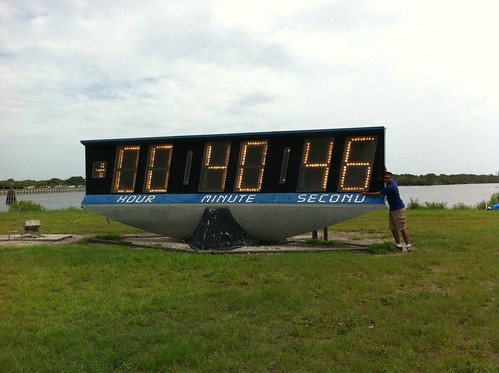
NASA Countdown clock for STS-135 Atlantis
The energy and excitement that my fellow SpaceTweeps and Tweetup attendees radiated was unbelievable at the press area. It’s like you instantly made 150 new friends just by walking into the tent. Everyone there immediately felt a connection with you just because we were all sharing in this wonderful experience. It’s been said on Twitter by many: “the launch only lasts 8 minutes, but the friends you make last a lifetime!” And truer words were never spoken for anyone who has ever attended a NASATweetup.
The advantage to arriving so early to the press area (0500 showtime!) is that we had a lot of time before the launch to hear from some very awesome people! We got to listen to the STS-1 Pilot Robert Crippen speak. This man is amazing! The stories he told were one in a million in so many ways. To listen to him speak at the final launch was really quite a treat.
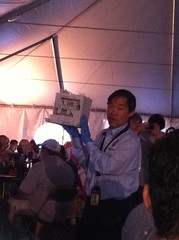
RRM mock up model
We also got to see a demo of the robotic satellite refueling mission that went up on Atlantis. The Robotic Refueling Mission (RRM) is a mockup of the real robotic refuler that will sit on the exterior of the International Space Station to run simulations and tests for the real mission. The demonstration was very informative and there were lots of questions asked and answered! The question I asked was ‘how many satellites can be refueled by one RRM?’ The answer was a simple ‘as many as we can!’ There are several variables that go into it, location of the satellites and the amount of propellent on board and things like that. Bottom line is, they will try to refuel as many satellites as they can. The RRM itself can be refueled so there is no telling how long it can stay up there once placed in orbit.
There were also several astronauts walking around the press area that were more than happy to speak to whom ever approached them. It was very nice to be able to speak with them and have them answer questions about what it’s like to be in space and how they got to be where they are today. The information is invaluable for those of us who still aspire to become astronauts one day (hint: that’s me!)
One of the main goals of the NASATweetup program is public outreach. NASA wants to get the word out to the public that despite this being the end of the shuttle launches, NASA is far from done with exploration and the space program. The term “Ambassador” was used to describe the “Tweeps” that attended the launch and I can’t think of a better term. The title really sank in for me when I realized that I was tweeting the whole morning right up until the launch. My tweets were re-tweeted by people I don’t follow or ones that don’t follow me. That’s when it hit me that just by adding the hashtag: #NASATweetup or #STS135 my tweets were reaching thousands of people. I then realized it was my responsibility and duty to tweet about my experiences for those that couldn’t be there to experience it first hand with me. It’s exciting to know that my tweets reached so many people. I had several friends tell me that they were jealous of my experience and commented on the pictures I posted to twitter. Most of these people are not a “space geek” like myself but when they saw those pictures and my tweets, they became just as excited and awed as I was. It may only last for a short time for them (it’s eternal for me) but in that short time, they loved space and I helped to inspire that in them.
The “Tweeps” also helped get the word out for NASA in their hometowns by doing interviews with local papers and news agencies. They became public figures in their own right just by being invited to the Tweetup. It became a point of pride for a person to represent their hometown or state or even country by attending the tweetup. There were several people from foreign countries there representing their entire nation. All in all the total was (I believe) 45 states and 16 countries were represented at the NASATweetup. That should tell you that NASA is not only a source of pride and inspiration for Americans but for the world over!
The events of the morning were great fun and all, but it was now getting time for the main event! There had been a concern all morning long about the weather. Everyone was near certain that there was to many clouds to launch and that it was going to be postponed. As launch time neared, the KSC Weather representative entered the Tweetup tent and informed us that there were still a few concerns about the weather but the board was GREEN and launch was still possible. The cheers and yells filled the tent and everyone was very excited. I went outside the tent about 30 minutes before scheduled launch time to get a prime viewing location just to the right and behind the countdown clock. I could still view the shuttle on the pad but wasn’t to concerned with that view as I knew as soon as the engines were ignited the shuttle was going to be climbing high into the sky. Because I was behind the clock I couldn’t actually see it counting down and I had no idea there was a hold at 31 seconds. Thankfully I didn’t have to endure that apprehension waiting to see if they were going to scrub with just a few seconds. I found out after the launch that there was a hold because the hood could not be verified via sensors that it was fully retracted. Luckily NASA has procedures in place to verify with cameras that the hood was indeed fully retracted and the countdown resumed with only a few minutes of hold time.
Less than ten seconds to ignition and the crowd starts counting down…10…9…8…7…I was getting very excited and could hardly contain myself. This moment topped every New Year’s Eve countdown I had ever heard. Finally (it seemed to take forever) the crowd yelled ONE and the solid rocket boosters ignited and the shuttle began to climb high. The flames coming out of the SRB’s was so very bright. It was like trying to look directly at the sun! At first you can only see the shuttle taking off and the flames burning, you cannot hear it at all. Then, that sound from the SRBs hits you and you can feel the rumble in your chest. The ground shakes a little bit and the crackling is all you can hear in your ears. It’s a glorious sound though and probably quite unique I would imagine. With there still being some cloud cover, Atlantis quickly moved out of sight but I was still looking up just in case I could catch a glimpse of it through the clouds.
Everyone around the press area was cheering and hollering as Atlantis climbed high into the sky. As I said, the shuttle was quickly out of sight in the clouds but everyone still hung around cheering and yelling with delight. A few minutes after
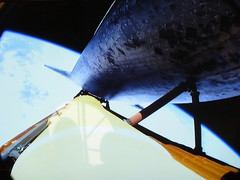
Atlantis went into the clouds the smell of the rocket fumes wafted over the press area. I knew you could see and hear a shuttle launch but I didn’t know you could smell one too! The “Tweeps” went back inside the tent to watch the live NASA TV feed of Atlantis climbing into orbit and the external tank separation. The tank separation is my favorite part to watch. I love to see it slowly
float down as the orbiter pulls away and climbs higher into orbit. It’s so graceful and majestic and I love to watch it happen.
After Atlantis was safely in orbit all the Tweeps hung around the tent. We definitely did not want the day to be over or leave all the great people behind. So Stephanie Schierholz declared an “open mic” and we all hung around and some people got up to thank Tweeps for helping out with their trips to FL, or to thank the NASA staff for being so awesome, or just stood up and asked if so and so was here because they wanted to give them a hug after all the communicating via Twitter. The generosity and kindness of Space Tweeps is unmatched in my opinion. There were several people that needed rides to airports or to houses or to the press site or any where else and Space Tweeps answered. Some people couldn’t order certain t-shirts or pins because they were overseas and other Space Tweeps rogered up and ordered the stuff for them and had it waiting for them when they arrived. The coordination and help that came out of the Tweetup was immense! And all Space Tweeps are to be commended!
I also have to take the time to thank a few people that really deserve a whole lot more than just my thanks! The woman who played a very large part in making the NASATweetup happen is Stephanie Schierholz (@schierholz). Without her a lot of things might not have happened and I certainly would not have been able to attend the launch from the press site. So a HUGE thank you to Stephanie for giving me this once in a lifetime opportunity. I could not thank you enough if I lived a 100 lifetimes.
The NASATweetup attendees also wanted to thank everyone involved who helped to organize the event and coordinated everything. Just so all of you know, these people did this despite having real jobs to do as well. That means that putting on a NASATweetup is not their full time job and they did all of this in addition to their daily duties at NASA. Which meant a lot of LONG days for them getting things ready for all of us grateful space tweeps! So as a small token of our thanks to them we all signed this poster for them and expressed our love and appreciation in words:
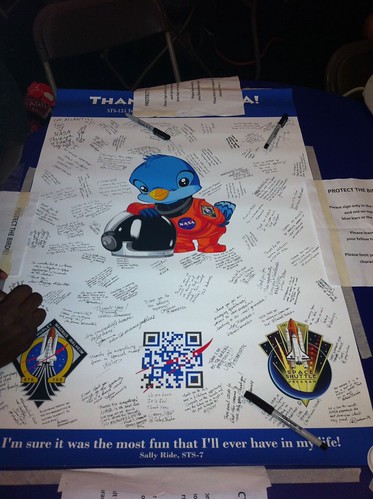
Thank you from the Tweeps!
Two more people that deserve a big thanks are Stephanie Collins (@stephonee) and Lauren (@ohlauren). These two magnificent ladies organized a lot of housing for a lot of Space Tweeps that they had never even met. They were lucky enough to attend the STS-134 (or was it 133?) Tweetup where someone had taken it upon themselves to organize housing in the area. Because of that, these two ladies decided to pay that act of kindness forward for the STS-135 Tweetup. I can only imagine the long hours and the amount of phone calls it took to get housing for everyone! And they did it without any compensation from those whom they found houses for. So this thank you is not enough but is most definitely deserved for the both of them! THANK YOU!
Again, I can’t express my feelings for being lucky enough to experience a shuttle launch first hand. Nor can I express my appreciation for all of the new friends that I have made through NASATweetups. A huge thank you to NASA and everyone involved in making this Tweetup happen. I will never forget the experience or the people that helped to make it happen for me.
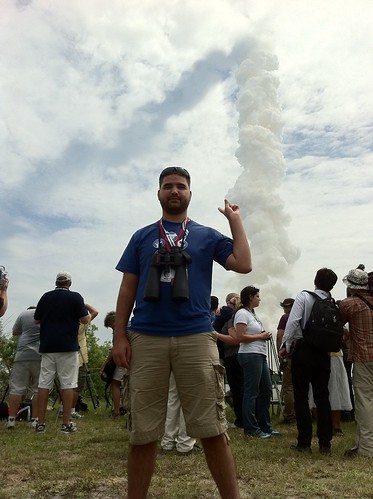
Me standing in front of the Atlantis plume

Zero Days to launch!
The rest of my photos are on flickr
Live long and prosper,
-Mark T. Clemente
*A Tweetup is a gathering of twitter followers to share in a unique experience. Find out more about NASATweetups here: NASATweetups






